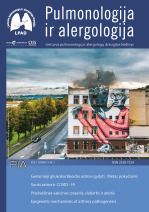CLINICAL, ANTHROPOMETRIC AND POLYSOMNOGRAPHIC DATA ANALYSIS OF NEW DIAGNOSED OBSTRUCTIVE SLEEP APNEA PATIENTS IN HOSPITAL OF LITHUANIAN UNIVERSITY OF HEALTH SCIENCES KAUNAS CLINICS IN 2019
Abstract
The aim of the study. To detect and evaluate the differences of anthropometric, clinical, and polysomnographic data of men and women with obstructive sleep apnea (OSA). Methods. A retrospective analysis was performed of data of 184 patients with OSA confirmed by polysomnography in 2019. Anthropometric, Epworth'o sleepiness scale and polysomnography data were evaluated. Study participants were divided into groups according to gender and the severity of OSA (mild OSA with apnea and hypopnea index (AHI) 5–15/h, moderate OSA – AHI 15–30/h, severe OSA – AHI more than 30/h). Results. 184 patients were included in the study, and OSA was diagnosed for 122 males and 62 females. 30 subjects (16.3%) had mild OSA, 55 (29.9%) – moderate OSA, and 99 (53.8%) – severe OSA. OSA was more prevalent in males than in females. More males (78 patients – 78.8%) had severe disease (p<0.001). The age of female patients with OSA was higher. Patients with severe OSA were older than those who had mild OSA (p<0.05). Weight, neck, waist circumference, and body mass index (BMI) averages were significantly lower in patients with mild to moderate OSA when compared to those with severe OSA (p<0.001). Males weight and neck circumference were significantly higher than females, and waist circumference did not differ. Comparing the differences between rapid eye movement and non-rapid eye movement sleep, specifically male patients in the non-rapid eye movement sleep showed a statistically significantly higher AHI and oxygen desaturation index at different sleep positions. Conclusion. Severe OSA was more prevalent in older patients. Females with OSA were older than males. Males were more likely to have a severe form of OSA. There was no correlation between OSA and BMI. A correlation between OSA severity and neck circumference, and body weight was found. The main male and female differences in polysomnography data were found during non-rapid eye movement sleep.


